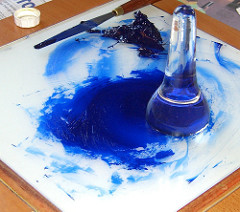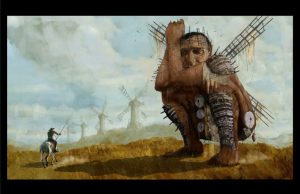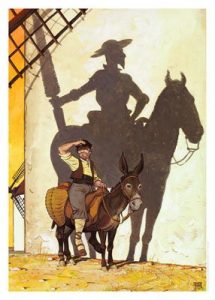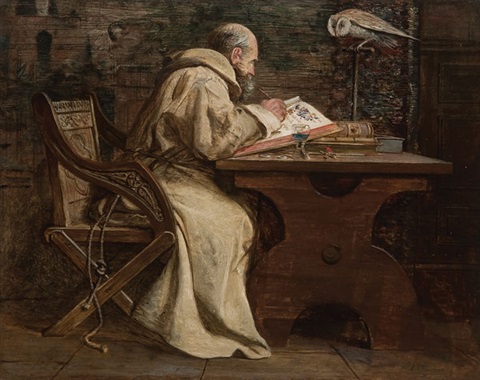The scriptorium workshop enabled me to see the difficulties of creating a narration of an illuminated letter. As mentioned in class today, in order for artists to illustrate effectively, they have to learn and understand the context of the story they are trying to exemplify through visual depiction. Since I did not have a story behind my letter “H”, it was difficult for me to add any surrounding detail beyond the lines of the letter. I chose this letter because it is my last name initial. This selection made me feel as though I needed to define myself and incorporate symbols of who I am. Summarizing one’s life or a creating emblems that are personal representations of themselves is no simple task. Similarly, as we talked about with Don Quixote, interpreting stories and illustrating scenes in a way that resonates with intended audiences and accurately depicts the author’s theme is a unique skill. This process of creating an illuminated letter allowed me to appreciate the creativity, patience, and reflection that illuminators and illustrators demonstrate in their art.
The Sane vs. the Insane
Since my senior year of high school, I have studied Don Quixote every single academic year. I have read multiple versions (in both English and Spanish), seen the ballet, listened to Spanish songs, watched movies, read poems, and seen many images that are based off the Spanish classic novel.
When I heard that I was, once again, going to study Don Quixote, and although I enjoy the story immensely, I was a little annoyed simply because I didn’t think we would study any new images. I’d seen the Picasso, I’d seen the Dali, I’d even seen some contemporary images of Don Quixote, Sancho Panza, and the windmills. However, as I often am, I was pleasantly surprised by the images used in the English translation we read for class today.
The above image followed the novel’s sixth chapter. I was struck by the Alice in Wonderland – like quality of the woodcuts featured in this particular translation. The interpretations to not match the images that filter through my imagination while I read, at all. And I liked that! It made me think about Don Quixote in a different way. I’ve always pictured Don Quixote as an old man shuffling around in the world – a character in a rather normal setting. But these images seem to suggest that it is not just Don Quixote that is the strange one. The priest and the barber in the above image look like disturbing dolls (nothing like sane human beings). The room in which the two stand do not have any sense of concrete space. Life-size scissors stand life-like in the corner (most likely there as an illusion to the fact that these men are cutting Don Quixote off from his most treasured possessions, and in turn, cutting him off from his fantasy world of chivalry). To me, this image shows that our actions, even those that seem logical, isn’t too others with a different option. While these men think it is best to destroy the books that Don Quixote loves, to Don Quixote and maybe to the readers too, destroying the books looks like an insane and insensitive action.
Should Novels Be Illustrated?
After we looked at several illustration of the novel Don Quixote and compared them in class, we raised the question of how to depict the depth of a character’s thoughts accurately. Illustrations are supposed to add a third dimension to a story without adding substance that was not there in the first place. There are always some aspects that cannot be fully grasped from reading, such as the internal mind of a protagonist. The readers must merely be able to understand the character by reading about him or her to then trigger their imagination. Where is that limit in creating an illustration for its maker? The role of illustrations should support the story without adding new information that is not explicitly concrete in the book. Is it fair to add details that the author perhaps didn’t want in their story that might distort the story or highlight subordinate ideas in the novel?
Is it possible that novels are designed to trigger the imagination and not to be accompanied by illustrations? Maybe the beauty of novels reside in that they create a different experience for each person and that this experience cannot be modified or mainstreamed by an illustration.
Visual Depiction of Don Quixote’s Imagination
As evidenced by Gustave Doré’s works that we looked at in class today, an artist depicting scenes from Don Quixote has to constantly consider how to represent the dichotomy of the protagonist’s imagination and reality. The two works below tackle this challenge. The first one, a visual from Terry Gilliam’s film, “The Man Who Killed Don Quixote,” shows the scene in which Don Quixote believes that the windmills are giants who he must defeat. The artist chooses to portray Don Quixote’s imagination as contemporaneous with and equivalent to his reality, including his envisioned identity as a knight. He makes Don Quixote’s confusion viable by giving the giant certain characteristics that closely resemble a windmill. While he does give credence to these ideas, the background of the painting also reveals the differing reality of the situation by showing windmills without giants.
The second illustration, by Daniel Torres, displays a shadow that embodies Don Quixote’s idealistic self-image as a confident knight with armor and a sword. His real identity in the world is depicted as a disadvantaged man wearing ratty clothing and sitting atop an animal that more closely resembles a donkey. This version of the protagonist looks out into the world of the viewer, shielding his eyes from the sun, as if preparing to confidently encounter the reality of his world with an imagination that contradicts it.
The Act of Illumination
I absolutely loved having the opportunity to workshop and attempt to make my own historiated letter. It really put all of our discussions of illuminated manuscripts into perspective when I realized the time and detail that went into a single letter, much less an entire illustration. It is such an involved process that much is left to the discretion of the illuminator. What struck me the most was the experience of applying the gold leaf. The process required a great deal more precision than I had anticipated but really transformed the entire work immediately. I was able to pick up the illustration and move it to see the light reflect off the gold leaf and it reminded me again of the movie The Secret of Kells in which the entire movie had been drawn in the style of illustrations come to life. The workshop has given me an entirely new appreciation for illuminated manuscripts–I could not imagine illuminating an entire manuscript, much less in the scale of the Book of Kells or the one of the pocket prayer books. Especially with the knowledge that the illuminators of the past would have been illustrating on parchment without the technologies like electricity.
Scriptorium and Style
Working on our own historiated letters in the scriptorium workshop for the last few classes has been a great experience. It has been fun while also making apparent just how much effort goes into a single letter of a manuscript. After this exercise, I can’t even imagine how long it would take and how much patience you would need to illuminate an entire book, especially since our letters were on a much larger scale than they would be in a manuscript, which made the detail work easier. While working on my own letter, I also saw a connection to the idea of style brought up in in Pamuk’s My Name is Red. I tried to combine my own geometric style with more traditional nature-inspired designs for my letter. In the novel, certain characters, like Enishte Effendi, assert that new styles can emerge from combining pre-existing methods of illumination. He says that even workshops can develop their own styles, which emerge from the individual techniques of each of the illuminators building off of one another and combining with the style of the old masters. However, in some passages of the novel, the characters wonder whether it is really possible to combine two different styles. According to Master Osman, the combination of Eastern and Western art in Enishte’s manuscript results only in illuminations that reflect less skill than those created using only one style. To what extent can you keep your own style while taking influence from other artists?
Reflections on our time in the scriptorium workshop
Two days in the scriptorium workshop really opened my eyes to the art of illustration. One thing that struck me was the time and planning that went into making a simple letter. It took me about 45 minutes of the first class just to map out where I wanted to place everything and getting my letter “M” to be symmetrical. Even just thinking about how I wanted to decorate my letter took a while. It made me realize how even the smallest distorted letter at the beginning of a page takes so much thought, planning, and execution of details. The second class, I was able to finish my illustration and begin the process of illumination. Deciding on which part of my illustration to illuminate was also a difficult choice. I wanted to use gold leaf in a relatively big area that was easier to put glue on, rather than any tiny details. I decided to do two concentric frames around my letter. Using the gold leaf really made my image come alive, and it was easy to see the appeal of using it in early manuscripts to make illustrations even more beautiful. Overall, my experience in the scriptorium was super enjoyable, and I loved engaging in an ancient art that proved way more difficult, detailed, and time consuming than I would ever have guessed.
Is Copying Art?
Before launching in to my point I should note that I do not encourage or support plagiarism. This is merely a rhetorical exercise. In My Name Is Red, the masters or those that are the best copiers. Their ability to copy the greats brings their work from “good” to perfection. During our workshop I attempted to draw Shekure. I pulled up an image on my phone of a character from the animated film “Kubo and the Two Strings.” For some reason that woman was exactly who I pictured when I read about Shekure. I love to copy or imitate artwork. I find it relaxing to follow the lines, colors, and elements of someone else’s work. Someone else, who, frankly, is much better at this than I am. What are the ethical implications of this? Is it wrong to produce work that’s not your own? What are you thoughts?
Illuminating and Connections to Kells and My Name is Red
Painting is not my strong suite; I’ve made some large abstracts in the past, but when it comes to intricate small scale drawing, it can be a mess. In class today I saw first hand the intricate detail and skill level, as well as the time and patience required to create beautiful and perfected drawings for manuscript. I began by making a historiated letter “R” and then trying to add a dragon next to it, which didn’t work out like I had hoped. However, I was intrigued by the juxtaposition of ideas in both the Book of Kells and My Name is Red. On one hand, My Name is Red can be interpreted as a Western text – although the illuminators at the time had to balance a fine line of drawing what the knew or saw, and avoiding creating idolatry – which would be sinful. Compared to the Chi Rho page in the Book of Kells, their idea of how their savior should be represented and revered is quite different: The Chi Rho page, as exemplified in the film we watched about Kells, is a wonderfully crafted and designed page, with the goal to awe and inspire the reader. I have been thinking about the comparisons between My Name is Red and Kells for a while now, so perhaps that may be the basis for my first essay. I was also very intrigued by the mixing of paint today, and it gave me a deep respect for the patience it took to set up painting – for I can imagine the mixing and creation of the paints would be quite an arduous process. It was heartening to see that the ancient art of creating paint for manuscripts is not lost even in the world of technology.
Put Some Respek on Illuminators’ Names!
Today we had our first scriptorium workshop. I left class with a new found appreciation for illuminations and their illuminators.

First, I saw how the paints were mixed. It is a meticulous process that takes time and patience to start from powder and water to eventually obtaining paint of the consistency that the artist wants. The paint also dries very quickly so the illuminators must have had to either work really quickly, or continuously keep mixing small amounts of paint.

I then moved on to creating a historiated letter. After one hour, I had only finished putting down some simple line work. I hadn’t added any details yet. When I look at the details in the illuminations in the Book of Kells, Book of Hours, or Très Riches Heures, I am stunned by the amount of time it must have taken to complete them.
After class I started thinking about how I have only done drawings that I have got to keep. I cannot imagine having to produce an illumination for someone who commissioned it. Furthermore, the illumination would have to incorporate all of the specifications that the patron wants in it. The fact that many of the patrons back then were rich and powerful would add extra pressure to produce a high-quality piece.
I also thought about how I was only able to draw what I did in class because I used reference images from the internet. The illuminators back then did not have smartphones on which they could casually quickly look up a vine, or a person, or a landscape. They had to work from memory from the things that they had seen with their eyes during their travels, or invent their own original designs.
It was also easy to draw because the room was well lit with consistent lighting. Back then, illuminators worked with the sunlight and possibly candles when it got dark outside. This must have made it difficult because paints look different in different lighting, so when the sun came up, they may have realised that what they spent the whole night working on did not turn out how they wanted it to, which must have been very frustrating.
After today’s lesson, all the illuminations that I have looked at look more beautiful that they did when I saw them before the class. Being able to get a hands on experience like today really made me appreciate the time and effort that illuminators put into their work.





